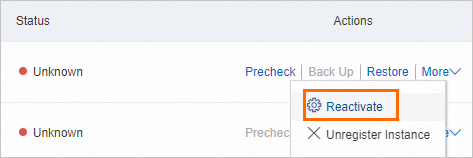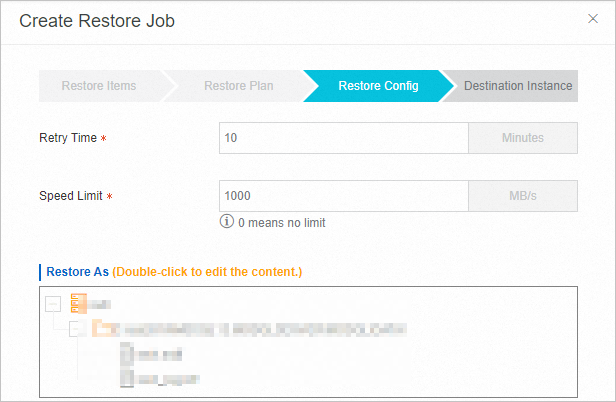This topic provides answers to some frequently asked questions (FAQ) about the database backup feature of Cloud Backup.
What do I do if the status of a MySQL database is Inactivated?

When you register a database, the value that you specify for Database Account or Password is incorrect, or you do not have the required permissions. After you check that the specified username and password are correct, grant the required permissions to the backup account. We recommend that you create a dedicated backup account.
The minimum permission set of the user is RELOAD, LOCK TABLES, REPLICATION, and PROCESS.
You can run the
systemctl status dbackup3-agentcommand to view the process status of the Cloud Backup client. The value active indicates that the client is running properly.● dbackup3-agent.service - dbackup3 agent daemon Loaded: loaded (/usr/lib/systemd/system/dbackup3-agent.service; enabled; vendor preset: disabled) Active: active (running) since Mon 2023-12-11 13:47:34 CST; 1min 13s ago Main PID: 22192 (dbackup3-agent) CGroup: /system.slice/dbackup3-agent.service └─22192 /opt/scutech/dbackup3/bin/dbackup3-agent -f /etc/opt/scutech/dbackup3/agent/svc.conf.d Dec 11 13:47:34 iZbp1******gktZ systemd[1]: Started dbackup3 agent daemon.The client log path is
/var/log/dbackup3/agent.log.
What do I do if the database status is Database Offline?

MySQL
Query the status of the MySQL database.
Log on to the Elastic Compute Service (ECS) instance and run the
systemctl status mysqldcommand to query the status of the MySQL database. The process status is inactive, indicating that the MySQL database service is not started.Restart the MySQL database service.
After you run the
systemctl start mysqldcommand to restart the MySQL database service, Database Status is Online in the console.
Oracle
Query the listening status of the Oracle database.
Log on to the ECS instance and run the following commands:
su - oracle lsnrctl statusIf the service is started, its status is running. If the service is not started, the TNS: no listener message is prompted.
Query the status of the Oracle database.
su - oracle sqlplus /nolog conn /as sysdba SELECT name, status FROM v$instance;The v$instance view provides the database information. The status column shows the database status. If the status is OPEN, the database is started and can accept connection requests.
Restart the Oracle listener.
Start the Oracle listener to listen to connection requests from clients.
su - oracle lsnrctl startRestart the Oracle database.
In SQL*Plus, log on as the system administrator and start the Oracle database.
sqlplus / as sysdba; STARTUP;After you start the database, Database Status is Online in the console.
SQL Server
Query the status of the SQL Server database.
Press
Win+Rto open the Run window.Enter
services.mscand press the Enter key to open Windows Services Manager.Find the SQL Server service in the service list. Example: SQL Server (MSSQLSERVER).
View the service status, which may be Running, Stopped, or Paused.
Restart the SQL Server service.
If the status of the SQL Server database is Stopped or Paused, right-click the SQL Server service and select Start. If the Start option is dimmed, we recommend that you reopen Windows Services Manager as an administrator and try again. After you start the database, Database Status is Online in the console.
How do I view the process status and log path of a Cloud Backup client and restart the client?
Linux:
View the process status of a Cloud Backup client.
Run the
systemctl status dbackup3-agentorservice dbackup3-agent statuscommand to view the process status of the Cloud Backup client for database backup. active ordbackup3-agent is running...indicates that the client is running properly.● dbackup3-agent.service - dbackup3 agent daemon Loaded: loaded (/usr/lib/systemd/system/dbackup3-agent.service; enabled; vendor preset: disabled) Active: active (running) since Mon 2023-12-11 13:47:34 CST; 1min 13s ago Main PID: 22192 (dbackup3-agent) CGroup: /system.slice/dbackup3-agent.service └─22192 /opt/scutech/dbackup3/bin/dbackup3-agent -f /etc/opt/scutech/dbackup3/agent/svc.conf.d Dec 11 13:47:34 iZbp1******gktZ systemd[1]: Started dbackup3 agent daemon.Restart the Cloud Backup client.
After you run the
systemctl restart dbackup3-agentorservice dbackup3-agent restartcommand to restart the client process, if Client Status of the database is Installed in the console, the client status becomes normal.
The client log path is
/var/log/dbackup3/agent.log.Windows:
Press
Win+Rto open the Run window.Enter
services.mscand press the Enter key to open Windows Services Manager.Find the
dbackup3-agentservice in the service list.Check whether the status of the service is Running. If the status is not Running, right-click the
dbackup3-agentservice and select Restart to start it.
The client log path is
C:\ProgramData\scutech\dbackup3\agent\log\dbackup3-agent.log.
What do I do if the status of a database client is Offline in the console?
Issue
Client Status of the database is Offline.

Cause
If Client Status is Offline, Cloud Backup fails to receive the heartbeat signal from the client process. This exception may be caused by various reasons. For example, the client is automatically terminated due to insufficient memory, or the device where the client is installed is shut down.
Solution
Check the client status by referring to How do I view the client process status and log path and restart the client?. Then, restart the client. Wait for a while if the client status is Running. If Client Status of the database is Installed in the console, the client status becomes normal.
Are limits imposed on the MySQL database versions and operating systems that support backup?
Cloud Backup supports a limited number of database versions, operating systems, and backup features. For example, Cloud Backup does not support backup of a MySQL database deployed on Windows. For more information, see the "Supported database versions" section in Overview (ECS-hosted databases).
How does Cloud Backup clear expired database backup files?
To perform an incremental backup, cumulative incremental backup, and log backup, Cloud Backup obtains the most recent backup files of full backup, incremental backup, cumulative incremental backup, and log backup. All backup files in a backup chain are retained in the backup vault until the last backup file expires. The backup files occupy backup space. We recommend that you configure a reasonable backup cycle and expiration time.
For example, you perform a full backup on September 1 and an incremental backup every day from September 2 to 7, and retain the backup data for seven days. In this case, the backup data from September 1 to 7 is retained until September 14 when all backup files expire.
How do I view the amount of database backup data and backup vault usage? Which item is used for billing?
Backup Data indicates the accumulated data volume of backup jobs. For example, after a 1 TB file is backed up twice, Cloud Backup saves two independent data copies, and the value of this parameter is counted as 2 TB. Cloud Backup deduplicates and compresses backup data to reduce the backup vault usage, saving your costs. The value of Vault Usage is used for billing. You can view the amount of database backup data and the backup vault usage on the Overview page in the Cloud Backup console.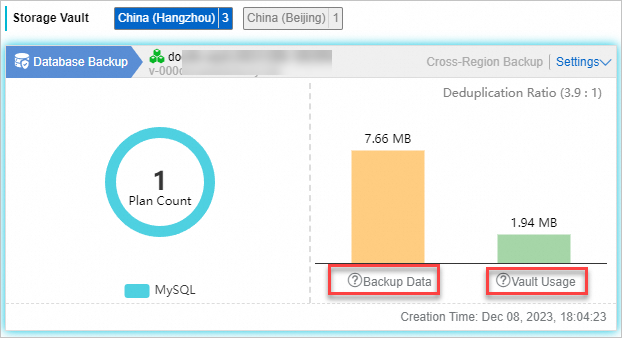
How do I cancel database backup?
How do I cancel MySQL database backup?
How do I cancel Oracle database backup?
How do I cancel SQL Server database backup?
How do I back up a new MySQL database?
Cloud Backup backs up MySQL databases based on database instances. No manual configurations are required for new databases. New databases are automatically backed up in the next backup cycle.
How do I resolve a data backup failure?
How do I resolve a MySQL database backup failure?
How do I resolve an SQL Server database backup failure?
What is a database backup vault?
Before you create a backup plan to back up a database, you must create a backup vault for the database.
A database backup vault is a storage vault that stores the backup data of your database. When you use the database backup feature, you are charged for the rental of database backup vaults and the storage usage. For more information, see Billing methods and billable items.
What do I do if the error message The difference between the request time and the current time is too large appears?
Cause: The difference between the time of the on-premises server on which the Cloud Backup client is installed and the time of the Cloud Backup backend server is greater than 15 minutes.
Solution: We recommend that you check the on-premises server time (time zone) and the Network Time Protocol (NTP) configuration. If an issue is found, modify the settings and restart the Cloud Backup client.
What do I do if I am unable to view database details when I back up an SQL Server 2019 database?
Issue: If you back up an SQL Server 2019 database by using Cloud Backup and other backup software or scripts at the same time, you may not be able to view the database details. When you create or edit a backup plan and select a database instance, the FailedToListUniBackupInstanceDetail error occurs.
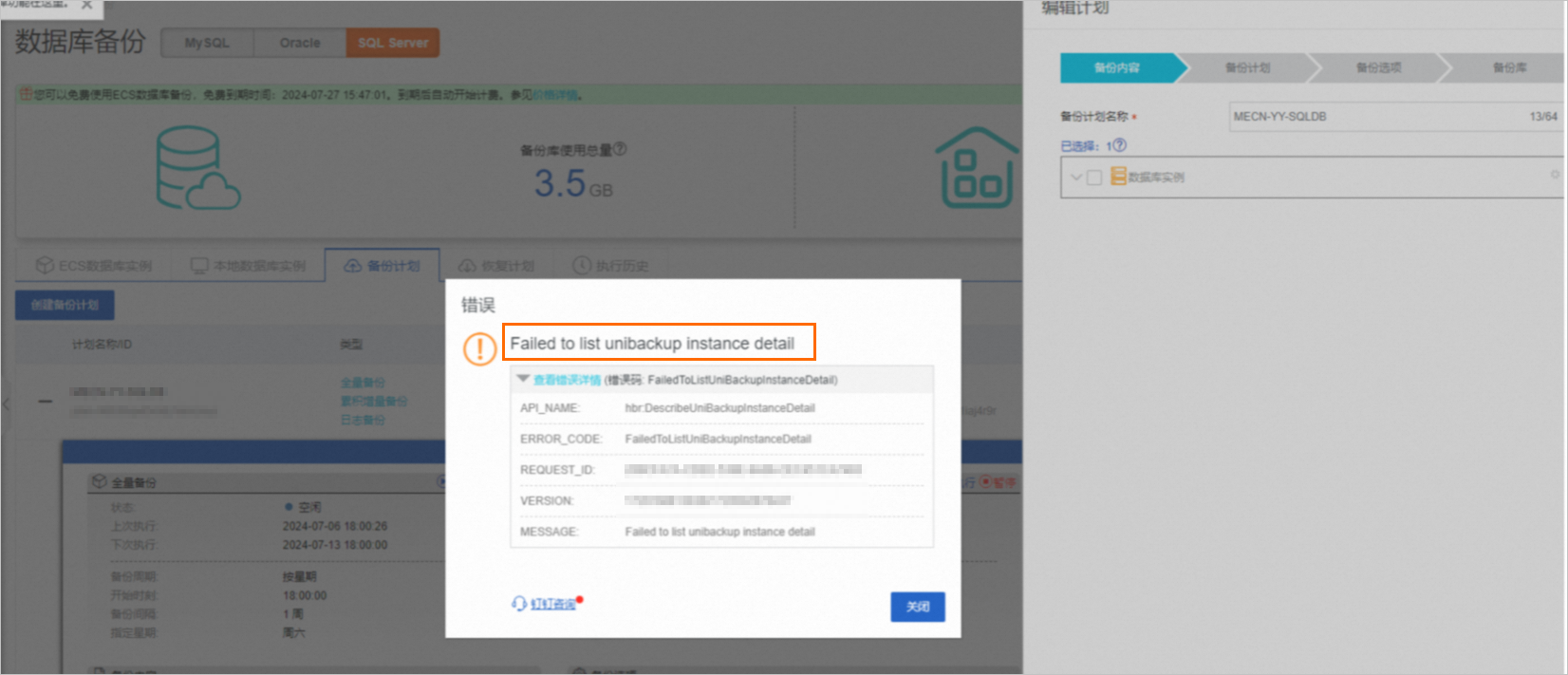
Solution
Query the number of databases and backup sets in your SQL Server database.
select count(database_id) from master.sys.databases select count(backup_set_id) from msdb.dbo.backupsetDelete backup records from msdb.dbo.backupset.
ImportantBefore you delete backup records, take note of the consequences. If you perform this step, the backup records created by other backup software or scripts are also deleted and cannot be restored. However, the backup of your database is not affected, because Cloud Backup automatically converts the next backup to a full backup. Note that SQL Server 2019 databases cannot be backed up by using Cloud Backup and other backup software or scripts at the same time.
use msdb; exec sp_delete_backuphistory @oldest_date = '04/10/2024' ---Retain the backup records created on and after April 10, 2024 and delete the backup records created before April 9, 2024. You must confirm the time.
What do I do if the status of an SQL Server database is Inactivated in the console?

When you register the database, the value that you specify for Database Account or Password is incorrect, or you do not have the required permissions. After you check that the specified username and password are correct, grant the required permissions to the backup account. We recommend that you create a dedicated backup account and try again.
Create an SQL Server backup account and grant the required permissions. For more information, see Step 2: Create a backup account and configure permissions and Step 3: Configure network settings.
Restart the
dbackup3-agentservice.Press
Win+Rto open the Run window.Enter
services.mscand press the Enter key to open Windows Services Manager.Find the
dbackup3-agentservice in the service list.Check whether the status of the service is Running. If the status is not Running, right-click the
dbackup3-agentservice and select Restart to start it.
If the service still fails to be activated after you restart the service, we recommend that you collect relevant logs for further analysis. The client log path is
C:\ProgramData\scutech\dbackup3\agent\log\dbackup3-agent.log.
How do I change my username and password used for database backup?
To change the username and password that are used for database backup, you can Reactivate your database. For example, you can reactivate your database if the database password expires. Reactivation does not affect the existing backup plan. You do not need to change the backup plan. However, reactivation has an impact on running backup jobs. We recommend that you perform the following steps:
On the Backup Plan tab, pause real-time log backup (if any).
Find the database and choose More > Reactivate in the Actions column.
What do I do if the following error message is returned when I install a Cloud Backup client to back up an on-premises SQL Server database: Failed to run install script:exit status 4?
The "User Account Control: Admin Approval Mode for the Built-in Administrator account" policy is not enabled. The policy must be in the Enabled state. You can perform the following steps to enable the policy.
Press Win+R to open the Run window. Run the
gpedit.msccommand to open the Local Group Policy Editor.In the Local Group Policy Editor window, choose Computer Configuration > Windows Settings > Security Settings > Local Policies > Security Options. Find User Account Control: Admin Approval Mode for the Built-in Administrator account and change the policy status to Enabled.
Why do multiple database instances appear on the ECS Database Instance tab after I register a database instance?
If multiple databases are deployed on an ECS instance, Cloud Backup scans and displays all the databases during registration in the console.

Why is the time when an alert notification is received different from the time when an error occurred?
Nighttime suppression is set for alert text messages. The system does not send text messages of the alerts generated from 20:00 one day to 08:00 the next day until 08:00 the next day. However, alert emails are not subject to this restriction and are sent immediately when alerts are generated.
Why do some repeated backup records or backup records that are executed at unexpected time exist in the backup history?
This issue generally occurs in the following conditions: 1. A server (an on-premises server or an ECS instance) on which the Cloud Backup client for database backup is installed is cloned. 2. An image that contains the Cloud Backup client is used to create an ECS instance or an on-premises server. The cloned server retains some information about the client on the original server. As a result, repeated backup records may be generated. To resolve this issue, you only need to log on to the cloned server and uninstall the Cloud Backup client. To uninstall a Cloud Backup client, perform the following steps:
Why do I receive an alert email or text message stating that the backup failed, but a backup success record and a backup failure record generated at the same time exist in the backup history?
This issue generally occurs in the following conditions: 1. A server (an on-premises server or an ECS instance) on which the Cloud Backup client for database backup is installed is cloned. 2. An image that contains the Cloud Backup client is used to create an ECS instance or an on-premises server. The cloned server retains some information about the client on the original server. As a result, repeated backup records may be generated. To resolve this issue, you only need to log on to the cloned server and uninstall the Cloud Backup client. To uninstall a Cloud Backup client, perform the following steps:
Why does the backup fail and the status of the backup plan is displayed as Error?
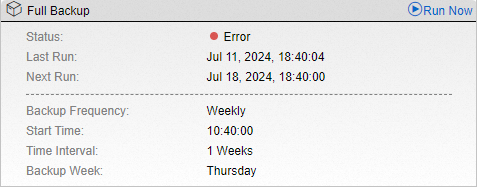
Check whether the server (an on-premises server or an ECS instance) on which the Cloud Backup client is installed has been cloned by using an image, the operating system has been reinstalled, or the system disk has been reset. These operations may invalidate the association between the backup plan and the client. To resolve this issue, perform the following steps:
Uninstall the client and its configuration files on the cloned server. For more information, see Uninstall the client.
Make sure that the status of the client on the current server is Installed.

After you perform the preceding steps, delete the original backup plan in the console and create a new backup plan.
Why does a database instance fail to be registered for backup?
Check whether a Cloud Backup client for database backup has been installed on the server (an on-premises server or an ECS instance). If a Cloud Backup client for database backup has been installed, uninstall the client and delete the related configuration files by referring to Uninstall the client. Then, register the database instance again.
How can I enable the free trial of the on-premises database backup feature?
The free trial of on-premises database backup is the same as that of ECS database backup. For more information about the free trial, see Usage notes of 30-day free trial.
What is the minimum interval for real-time backup? Can I configure real-time backup and incremental backup at the same time?
In theory, real-time backup can achieve recovery point objectives (RPOs) in seconds. Real-time backup applies to MySQL and Oracle databases. After real-time backup is enabled, traditional log backups can no longer be configured independently. However, the real-time backup can still be configured with incremental backup to further enhance data protection.
What are the network requirements for on-premises database backup?
The on-premises database server is connected to a virtual private cloud (VPC) by using a virtual private network (VPN) gateway or Express Connect circuit. One of the following CIDR blocks can be used for communication between the on-premises database server and Alibaba Cloud: 100.64.0.0/10, 100.64.0.0/11, and 100.96.0.0/11.
What do I do if the Cloud Backup client for ECS-hosted database backup failed to be installed?
To ensure that the Cloud Backup client for ECS-hosted database backup can be installed successfully, check that Cloud Assistant is installed and running properly. If the Cloud Backup client failed to be installed, you can find a failure command record in the Cloud Assistant console. We recommend that you copy the command to your ECS instance and manually execute the command. If a network connection error or system script execution error occurs during the manual installation, the specific error information appears. Resolve the issues as prompted. For example, adjust the network settings. If all issues are resolved and the script is executed, the Cloud Backup client is installed successfully. Then, trigger the installation in the Cloud Backup console to install the client.

